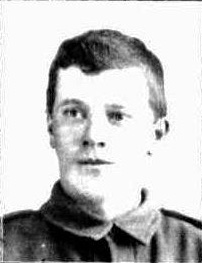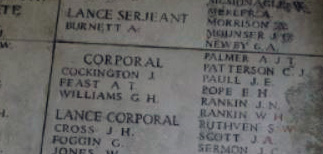Arthur Thomas Feast
From Our Contribution
 photos Western Mail 18 May 1917 & 3 Sep 1915 pages 23 & 1S | |
 | |
| Personal Information | |
|---|---|
| Date of Birth | ?? Dec 1894 |
| Place of Birth | Southern Cross, Western Australia |
| Death | Died of Wounds 28 Sep 1917 |
| Place of Death | Polygon Wood, Ypres Salient, Belgium |
| Age at Enlistment | 21 years, 2 months |
| Description |
5'11" (1.80m) tall ; 150 lbs 68.039 kg ; fresh complexion ; blue eyes ; light brown hair |
| Occupation | Timber worker |
| Religion | Roman Catholic |
| Address | Serpentine, Western Australia |
| Next of Kin | Father , Mr Henry Feast |
| Military Information | |
| Reg Number | 5715 |
| Date of Enlistment | 20 Mar 1916 |
| Rank | Corporal |
| Unit/Formation | 16th Battalion, 18th reinforcement / 4th Brigade, 4th Division |
| Date of Embarkation | 18 Jul 1916 ‒ 9 Sep 1916 |
| Ship Embarked On | HMAT A48 Seang Bee Fremantle to Plymouth |
| Fate |
Wounded in Action 5 Feb 1917 Flers Wounded in Action 12 Jul 1917 2nd Bullecourt Wounded in Action 28 Sep 1917 & Died of those Wounds 28 Sep 1917 Polygon Wood area |
| Monument |
Mundijong Honour Roll Serpentine Roll of Honour Menin Gate Memorial Jarrahdale Honour Roll ANZAC Memorial Park (Byford) Australian War Memorial |
| Medals |
British War Medal Victory Medal |
Pre War
Found in school registers at Serpentine from 23 Feb 1903 until he left school on 18 Dec 1908.
War Service
Arthur completed his training in Western Australia and later with the 4th Training Battalion at Rollestone in England following his arrival there on 9 Sep 1916. On 14 Oct 1916 Arthur was posted to France to reinforce the 16th Battalion, joining them on 30 Oct 1916. The battalion at that time was still recovering from the heavy casualties suffered by them at Mouquet Farm during August. When Arthur joined them they were manning the reserve line at Woodcote Farm just south of Ypres. Soon after, the battalion was withdrawn to spend time in the Anzac Rest Area near Abbeville to rebuild and retrain.
This training was followed during the winter with work on maintaining roads and railway lines before a brief return to the front during the first week of December at Guedecourt. Arthur was wounded for the first time with a gunshot wound to his left knee during the early morning of 5 Feb 1917, two days after the battalion had re-entered the front lines. He was one of a group of 50 men sent to reinforce the 13th Battalion which was being attacked on the 16th Battalion's right flank. The group took heavy casualties from enemy artillery fire. Seen in France by the 3rd Stationary Hospital on 7 Feb 1917 before being evacuated two days later from Le Havre aboard HMHS Dunluce Castle to England where he was admitted to the 3rd Southern General Hospital in Oxford on 10 Feb 1917. Arthur was well enough to be released a month later on 12 Mar 1917, and after a fortnight's furlough reported to No. 1 Command Depot at Perham Downs on 12 Mar 1917. His return to France through Folkestone took place on 29 Apr 1917, and he eventually rejoined the 16th Battalion on 3rd May 1917.
Arthur was appointed Lance Corporal on 30 May 1917, and within another fortnight had participated in the battle for Messines in the Flanders region of southern Belgium. He was wounded for a second time on 12 Jul 1917 by shrapnel piercing his back while he was in the support lines near Ploegsteert Wood. Treated first by the 13th Field Ambulance, and then the 2nd Australian Casualty Clearing Station between 12 and 19 Jul 1917 when he was placed aboard Ambulance Train No. 12 for admission to the 1st South African General Hospital in Abbeville. Discharged following treatment on 26 Aug 1917, he then spent time with the 5th Convalescent Depot in Cayquax before he was released to rejoin his unit on 10 Sep 1917, south west of the front line at Ypres.
Four days later Arthur was promoted Corporal, as the battalion readied itself for another stint on the front line. On the 23 Sep 1917 they relieved the 22nd Battalion in the Support Line, and made preparations for an attack on the German front lines at Passchendaele. At 2:30am on the 26 Sep 1917 the Battle for Polygon Wood began with Arthur and his mates in their jumping off position in the middle of no-man's land. Their objective was 800 metres in front of them. The support artillery barrage commenced at 5:50am, and the 16th Battalion advanced behind the creeping barrage, gaining its objective by 6:50am, after which they began to dig in. The 14th and 15th Battalions then moved through them to secure additional territory before the expected German counter attack. The counter attack eventuated, but was dispersed and broken up by artillery fire more than 300 metres from the 16th Battalion's position.
Arthur's luck finally ran out on the 28 Sep 1917, just hours before his unit was relieved by the 48th Battalion allowing them to move to relative safety in the rear. This time his wounds were more severe, although his records don't tell us what they were. He is recorded as having Died of Wounds received, and his burial, while initially thought to be in the 1st Anzac Cemetery, Burien, Belgium, was never found by the Commonwealth War Graves Commission. His name is recorded on the Menin Gate Memorial Bay 17 Stone H (and on Panel 191 at Australian War Memorial in Canberra).
Red Cross file: [1].
"... I did not know Feast very well, as I had been away, wounded, and when I rejoined Feast was a new man to me. He was tall 5 ft 11 in, I should say, smart, built, fair complexion about 26 years of age. We had been relieved and were just at a junction of two roads, a platoon in strength, and the men got a little scattered just as we were passing a limber on the side of the road when a shell of heavy explosives fell just in our midst but over us. I was the last man in the platoon, and remained to collect our wounded. Three were killed. It was pitch dark, except for the flash of guns, gas shells were falling around us. I was partly dazed, and got to work to move the wounded to a dressing station 200 yards back. Two Machine Gunners volunteered to assist me. After we had removed our three wounded, we went back to collect the pay books of the killed, when we found the man I think was Cpl Feast, a few yards off the road, but he might have got there to get past the limber. He was then unconscious and breathing very slowly. We at once conveyed him to the dressing station. One arm was broken at the wrist and terribly shattered near the shoulder. He was a tall man and had equipment on the same as us. I did not see his face or recognise him as Cpl Feast at the moment. He was immediately attended by the M.O. and I returned to collect the pay books of the killed. I think one of the gunners took Feast's paybook and I handed it in with the others to our Battalion headquarters. When I returned to the dressing station, one of the Red Cross men told me he was breathing better and a little later they said he had died. There was a great deal of confusion as we were being heavily shelled with gas and other shells and the Ambulance people were very heavily taxed....." [2]
Casualty List 351 advises of his death from injuries received in battle.[3]
Notes
While father was his NOK, Mother Mary Feast was the beneficiary of his estate. His Will was made before leaving Australia. Effects returned include a prayer book, and a note book.
For other information relating to Arthur Feast's war experience read "The Old Sixteenth" by Captain C. Longmore
References
- ↑ "Australian Red Cross Wounded and Missing Files - Arthur Thomas Feast". Australian War Memorial. 2018. Retrieved 2 May 2018.
- ↑ letter from Elliot J. Cpl
- ↑ "WESTERN AUSTRALIA.". The West Australian. XXXIII, (4,867). Western Australia. 8 November 1917. p. 5. Retrieved 22 June 2017 – via National Library of Australia.

